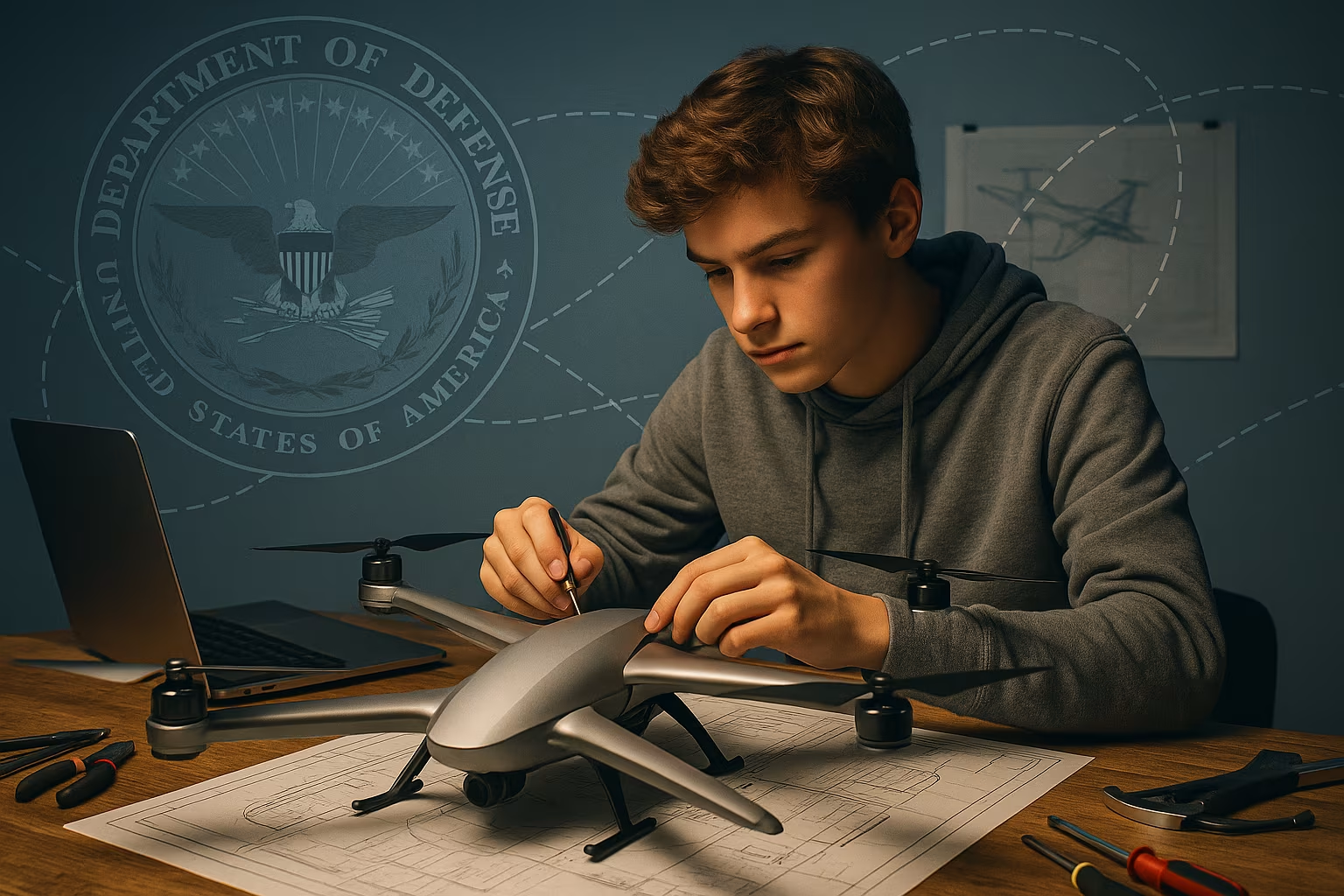At just 17 years old, most teenagers are juggling high school assignments, extracurricular activities, and college applications. But for one young inventor, the past year has been defined by something far more extraordinary — designing a cheaper, more efficient drone that caught the attention of the U.S. Department of Defense (DoD). His innovative creation not only impressed military engineers but also earned him a $23,000 award to further develop his design.
This remarkable achievement underscores the growing role of young innovators in shaping the future of technology, particularly in the fast-evolving world of unmanned aerial vehicles (UAVs).
A Drone Designed With Purpose
The teenage inventor, whose work stood out in a DoD innovation challenge, set out with a simple but ambitious goal: to design a high-performance drone that could be produced at a fraction of the cost of existing models. Commercial drones have become increasingly sophisticated, but that often comes with a high price tag and limited accessibility for smaller organizations, hobbyists, and humanitarian efforts.
His design focused on three key areas:
- Affordability — reducing manufacturing costs without sacrificing performance.
- Energy Efficiency — improving flight duration while minimizing battery usage.
- Versatility — making the drone adaptable for a range of tasks, from surveillance to search-and-rescue missions.
The result was a prototype that delivered competitive flight capabilities at a price point significantly lower than many industry-standard drones.
Breaking Down the Innovation
One of the most impressive aspects of the teen’s creation was the way he approached efficiency. Using lightweight but durable materials, he reduced the drone’s overall weight, allowing for longer flight times without the need for oversized batteries. His design also incorporated aerodynamic optimizations, minimizing drag and improving stability in adverse weather conditions.
Perhaps most notably, he built the drone using off-the-shelf components and open-source software. This made the system easier to maintain, upgrade, and replicate — a critical factor in lowering overall production costs.
In terms of capabilities, the drone featured:
- High-resolution cameras for detailed aerial imaging.
- Stabilized flight control for precise maneuverability.
- Longer operational range than comparable budget drones.
- Modular attachments that could be swapped out depending on the mission.
Recognition From the Department of Defense
The Department of Defense’s interest in the project came through a youth innovation competition designed to identify promising talent in emerging technology fields. The teen’s drone stood out not only for its technical performance but also for its potential real-world applications.
The DoD’s $23,000 award will allow him to refine the design, test it under more demanding conditions, and explore scaling up production. While military applications were part of the consideration, the technology also has strong potential for non-military uses, including:
- Disaster relief — deploying low-cost drones for damage assessment and locating survivors.
- Environmental monitoring — tracking wildlife, mapping forests, and monitoring climate impacts.
- Agriculture — surveying crops and managing irrigation more efficiently.
Inspiring the Next Generation of Engineers
Stories like this are inspiring not just because of the achievement itself, but because they highlight how accessible technology has become for young creators. Ten years ago, designing a competitive UAV would have required access to specialized labs and expensive proprietary hardware. Today, with affordable 3D printing, open-source flight software, and online engineering communities, teenagers can bring their ideas to life from their bedrooms or local makerspaces.
The 17-year-old’s success is also a reminder of how STEM education and extracurricular programs can foster innovation. Robotics clubs, science fairs, and online courses provide the foundational skills young engineers need to solve real-world problems.
The Expanding Role of Drones
The timing of this breakthrough couldn’t be more relevant. Drones are becoming increasingly integral to industries ranging from film production to public safety. They’re used for delivering medical supplies in remote areas, assisting firefighters, and conducting high-precision industrial inspections.
In the defense sector, UAVs have evolved from reconnaissance tools to multifunctional platforms capable of carrying sensors, communication equipment, and even payloads. However, the high cost of advanced drones has been a limiting factor, especially for smaller agencies and organizations. A design that balances affordability with capability could make UAV technology far more accessible worldwide.
Overcoming Challenges in Drone Development
While the teen’s design has already proven successful, bringing any new drone to market involves significant challenges. Manufacturing at scale requires maintaining quality control while keeping costs down. Regulatory approval is another hurdle, especially when drones are intended for commercial or government use.
There’s also the question of competition. The drone market is crowded, with established manufacturers continually releasing new models. However, the DoD’s recognition gives this young innovator both credibility and resources, which could be game-changing in the race to develop cost-effective UAV solutions.
Looking Ahead
With $23,000 in funding, the 17-year-old plans to enhance the drone’s design, test it in a variety of environments, and explore additional features, such as:
- Extended battery life through solar-assisted charging.
- Improved obstacle detection using AI-powered vision systems.
- Swarm coordination capabilities for multiple drones to operate together.
If successful, these advancements could place his creation in direct competition with higher-end models currently on the market, but at a fraction of the price.
The Department of Defense has a history of investing in innovative young minds, but this award also reflects a growing awareness that solutions to complex problems can come from unexpected places — even a high school student’s workshop.
The story of this 17-year-old inventor is a testament to creativity, persistence, and the democratization of technology. By designing a drone that is cheaper, more efficient, and adaptable for multiple uses, he’s not only captured the attention of military experts but also inspired countless young people to see themselves as potential problem-solvers and innovators.
As technology continues to advance at an unprecedented pace, the next big breakthrough might not come from a corporate lab or government research facility — it could come from a teenager with a big idea and the drive to make it real.





